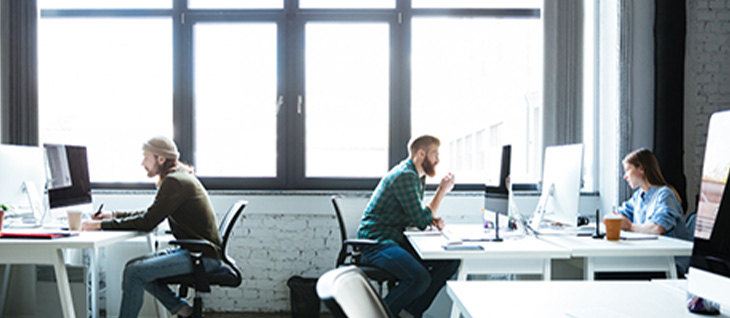Now the dust has settled on what Forbes termed The Largest Work-At-Home Experiment Ever, leaders now need to be evaluating how they can best navigate this new and exciting world.
While a range of unconnected so-called point solutions may have worked well in the past, with the changing and more nuanced nature of the modern workplace a different approach is necessary. Having a disconnected set of solutions is counterproductive to increasing productivity and agility.
Let’s explore the benefits of the key components in a more joined-up technology toolkit for today’s hybrid workplace.
The challenges ahead
With the move to hybrid working becoming the norm, real estate leaders need to look at solutions for:
Space usage – workers will be spending less time in a physical office. In addition, the nature of the space usage will change with a move to shared seating. The challenge for real estate leaders is forecasting future space needs.
Safety – real estate leaders still need to be alert and sensitive to workers’ concerns about cleanliness and physical distancing as they return to work. Creating a welcoming and safe environment for visitors and staff is paramount for physical and mental health.

Productivity – with staff gravitating between office and home, creating as frictionless experience as possible is key to their overall productivity.
Digital experience – for todays’ digital nomads, having a mobile and easy to use digital experience is key to how they interact with the building and each other.
Why integration?
With a fully integrated software and hardware ecosystem you can easily extend the utility of your solutions, remove unnecessary duplication of effort, create a seamless employee experience and a wealth of actionable data.

Our recommendation is that you find a vendor with an open API so that you have total flexibility and control over the destiny of your workplace ecosystem.
How does the integration work?
Connecting solutions for room booking, hoteling, occupancy measurement, digital signage and desk panels creates an ecosystem which addresses:
Space Utilisation -thanks to occupancy sensor technology it is easy for real estate leaders to gather real-time information about how their desk space is being used.
Integrating the sensor technology with the room booking solution, gives real estate leaders added data on how their space is being used.
Armed with this data, decisions can be made about how the space is used in future and as patterns of usage can be determined. Future ideas about the optimum workplace design can also be visualised. Our recommendation would be to evaluate at least 12 months data when undergoing such a process.
Safety – integration between room and visitor management software creates a frictionless and efficient way of managing the safety of meeting attendees. As soon as a booking is confirmed, health questionnaires are sent to the attendees and hosts. Only on successful completion of the questionnaires can they enter the building – subject to further checks of course.
For desk users there are two safe options – occupancy sensors or desk panels. Integration between occupancy sensors and digital signage offers users a simple and touch free check in/out process. Users simply identify a free desk on the signage, walk up and check in. To check out – they simply walk away – it could not be easier or safer.
Desk panels integrated with hotelling software offer a great way of keeping safe for organizations with allocated seating policies. Simply put, thanks to color coding users can see using a traffic light system which desks are free, in use or being cleaned. Touch-free QR code or RFID check in/out ensures that the space is being used and if it isn’t the hoteling software will auto-release the desk – another great space utilisation feature.
Productivity – A recent Gartner survey found that 6 out of ten workers were more productive thanks to flexible hours and hybrid working:
A connected workplace can help save them time. As we have seen, sensor technology offers them a time-saving check-in process. For meetings and allocated seating, a booking system is more appropriate and with Outlook integration, users can book their workspaces straight from their Outlook calendar – another great time-saver.
Of course, meetings in the hybrid workplace are often taking place via video conference. The new breed of meeting room software fully integrates with all the major platforms such as Team and Zoom to create a great meeting experience for both physical and virtual attendees.
Digital Experience – this has gone from a “nice to have” to a “must have” – as the above infographic shows.
Mobile apps simplify the process of booking rooms, desks and catering and AV. Floorplan-based booking on a mobile app – with Outlook integration – is the simplest way for users to locate and book their desks and rooms. Simple drag and drop enables to add catering or AV equipment.
Of course, hybrid working is more than about sitting at a desk. It is also about collaboration – thankfully the new breed of floorplan-based booking includes features for finding a colleague.
Conclusion
The use of point solutions in an isolated siloed manner is a short-sighted way to manage the workplace particularly in a new working environment where workers value a great digital experience and is a key prerequisite to them staying.
As the saying goes “two heads are better than one” and connecting software and hardware together to create a bespoke ecosystem is greater than the sum of the parts – users get an easy to use digital experience and you get all the data you need to drive change.
Check out the IDC case study video to see how our solutions have driven process improvement and fostered collaboration and innovation.


